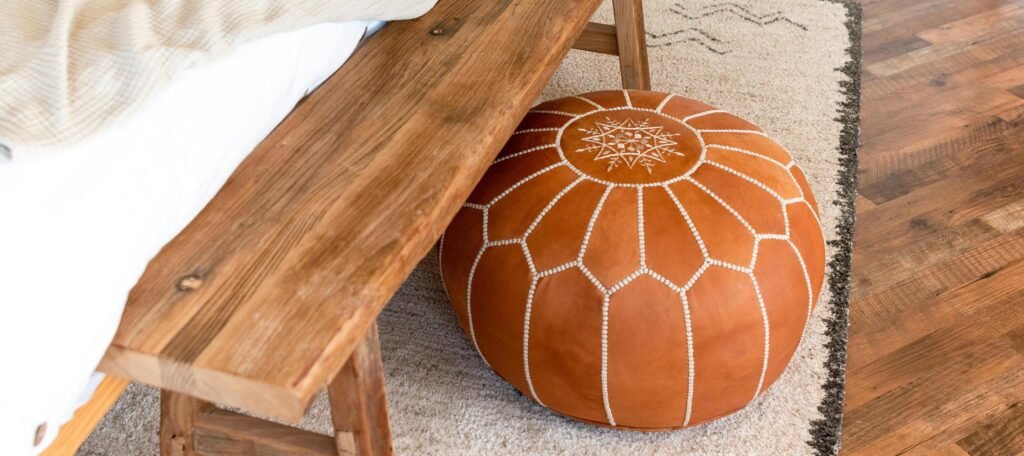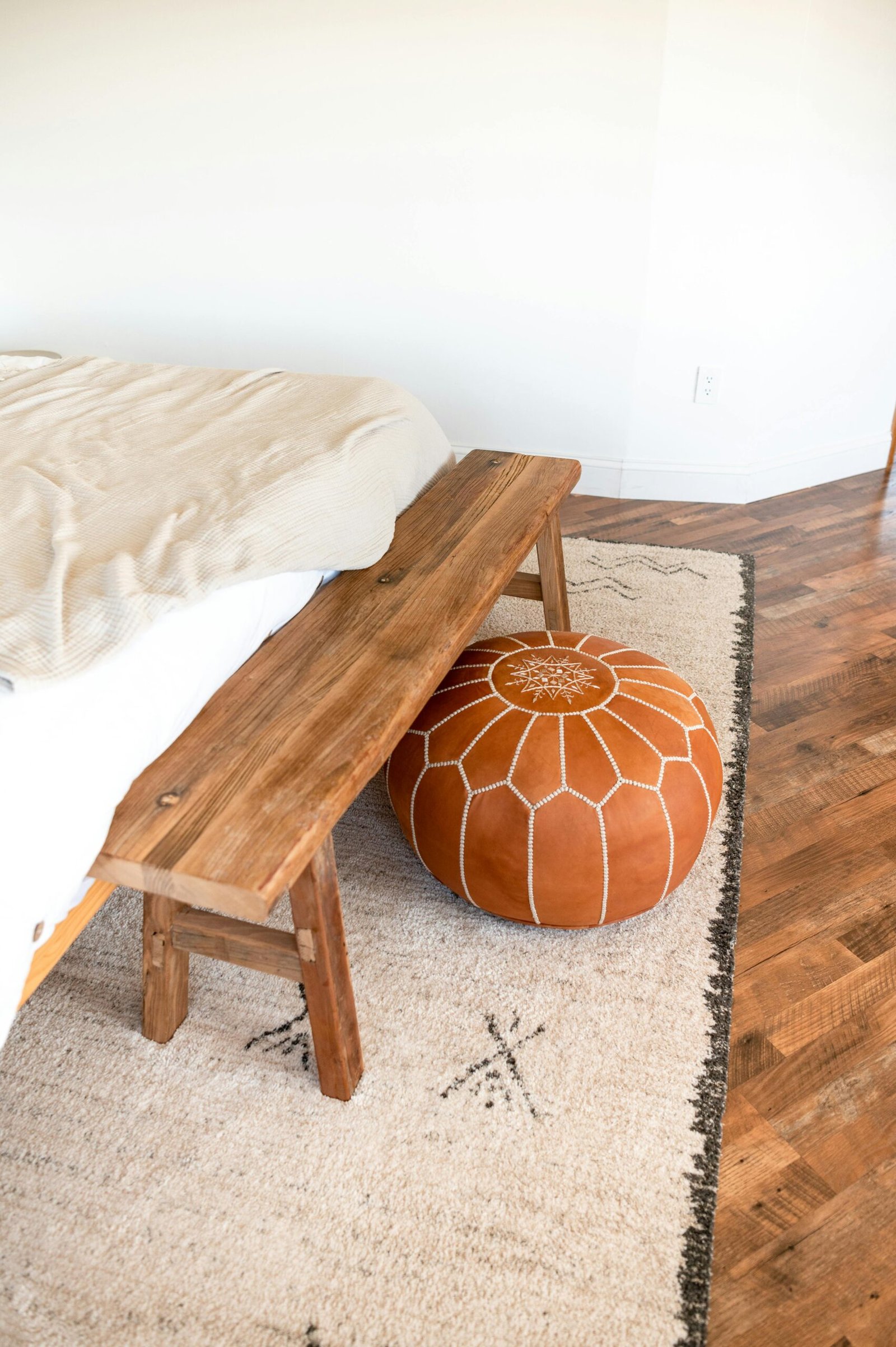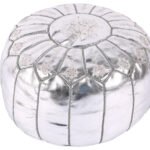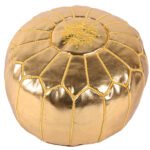
Introduction to Moroccan Poufs
Moroccan poufs are more than mere decorative items; they reflect a rich tapestry of culture, history, and artistry that has evolved over centuries. Traditionally, these poufs served not only as seating but also as functional elements within Moroccan homes, embodying the warmth and hospitality that are hallmarks of Moroccan culture. These versatile pieces have been integral to Moroccan interior design, offering both functionality and comfort in communal spaces. Crafted primarily from leather, fabric, or textile remnants, Moroccan poufs have historically been hand-stitched by skilled artisans, highlighting a dedication to craftsmanship passed down through generations.
With their roots deeply embedded in Moroccan society, poufs have transitioned from traditional household items to sought-after decor elements in various parts of the world. Today, they are celebrated for their aesthetic appeal and versatility. Homeowners and interior designers increasingly incorporate these pieces into modern settings, often using them as colorful accents to complement contemporary decor. The rich, vibrant hues and intricate patterns found in Moroccan poufs catch the eye and invite intrigue, making them popular choices in many households.
The evolution of Moroccan poufs from local craftsmanship to a global trend illustrates the impact of cultural exchange and appreciation of heritage. While they enhance various design aesthetics, be it bohemian, rustic, or minimalist chic, they also carry with them stories of artisan traditions. As the demand for sustainable, handmade products grows, Moroccan poufs stand at the forefront of this movement, offering consumers a connection to authentic craftsmanship. Understanding the artistry that goes into creating these pieces is crucial for appreciating both their historical significance and contemporary relevance.
The Legacy of Handmade Craftsmanship
The production of traditional Moroccan poufs is not merely a craft; it embodies a legacy that has been meticulously preserved through generations. This rich history is rooted in a commitment to artisanal techniques that reflect the cultural heritage of Morocco. Every pouf is a testament to the dedication of skilled artisans who have inherited their knowledge from their forebears. These craftsmen and craftswomen are often the last in a line of specialists who have honed their skills through years of practice, ensuring that each piece they create adheres to the time-honored methods that define Moroccan craftsmanship.
From the careful selection of leather to the intricate stitching patterns, each aspect of producing a pouf requires exceptional skill and attention to detail. Artisans often work with natural materials, further establishing a connection to their environment and underscoring the sustainability of their methods. The use of traditional tools and hands-on techniques insists on a tactile relationship between the artisan and their work, elevating each pouf into a one-of-a-kind piece of art. As a result, the unique characteristics that emerge from each pouf are reflective of the individual’s craftsmanship, making them distinct and treasured items.
In contemporary times, the importance of preserving these traditional methods is becoming increasingly complex. With the rise of mass production and globalization, authentic craftsmanship risks being overshadowed. Nevertheless, the artisans remain committed to their practices, embracing their role as custodians of Moroccan artisanal heritage. By prioritizing quality and individuality over quantity, these craftsmen offer a counter-narrative to industrialization, highlighting the value of handmade items. Thus, the legacy of handmade craftsmanship not only enriches the cultural landscape of Morocco but also fosters a greater appreciation for the artistry encapsulated within each pouf.
Materials That Make a Difference
In the production of traditional Moroccan poufs, the choice of materials is paramount to the craftsmanship and quality of the final product. Primarily, genuine leather is one of the most common materials used, often sourced from local tanneries that practice age-old techniques to ensure each piece retains its unique character and durability. The rich, natural aroma of the leather combined with its ability to withstand the test of time makes it a favored option among artisans and consumers alike.
Aside from leather, various textiles are utilized to craft Moroccan poufs, including cotton, wool, and silk. Each fabric brings its own aesthetic appeal and tactile experience, creating a diverse range of styles that can suit different interior settings. Cotton, for instance, is lightweight and breathable, making it an excellent choice for casual, comfortable designs. In contrast, wool offers warmth and a degree of resilience, ideal for styles emphasizing cozy environments. Silk, known for its luxurious texture, adds a distinctive elegance, enhancing the visual richness of the poufs.
The sourcing of these materials not only affects the quality and durability but also plays a significant role in sustainability practices. Ethical sourcing is becoming increasingly crucial in the production process, encouraging artisans to work closely with suppliers who practice environmentally friendly and humane methods. By prioritizing sustainable materials, artisans not only contribute to the preservation of the traditional craft but also ensure that the production of Moroccan poufs positively impacts local communities.
Ultimately, the materials chosen in the crafting of Moroccan poufs serve to enhance not only the aesthetic qualities but also the ethical implications of their production, creating products that are both beautiful and responsible.
Traditional Techniques of Creation
The creation of traditional Moroccan poufs is a meticulous process that blends artistry with age-old techniques, ensuring each piece is unique and authentic. The first step in this intricate journey is cutting the leather or fabric. Artisans often prefer using high-quality cowhide or goat leather, chosen for its durability and texture. Each piece is carefully measured and cut, allowing for precise shaping that will ultimately determine the pouf’s final appearance.
Once the material is prepared, the next stage involves stitching, a technique that highlights the craftsmanship involved. Artisans employ a variety of stitching techniques, often using thick, durable threads to ensure longevity. This step is not just functional; it is also an opportunity for creative expression. Decoratively stitched patterns can be incorporated, allowing for customization that reflects personal or regional styles. Many artisans have inherited these methods from their forebears, and their skill is a testament to years of practice.
The stuffing process is equally essential, as it dictates the poofiness and comfort of the pouf. Traditional methods often involve natural fillings, such as wool or cotton, which create a soft yet sturdy structure. Each pouf is filled to a specific level, ensuring it can withstand regular use while retaining its shape over time. After stuffing, the finishing touches are applied, which may include additional decorative elements or protective coatings. These final steps are crucial as they accentuate the pouf’s aesthetic appeal, offering various colors and finishes that cater to diverse tastes.
Overall, the traditional techniques of cutting, stitching, stuffing, and finishing have been refined throughout generations. These processes not only ensure quality craftsmanship but also preserve the rich cultural heritage inherent to Moroccan poufs, making each item a piece of art.
A Day in the Life of a Pouf Artisan
The journey of a pouf artisan begins at sunrise, as the first light filters into their workshop, often a humble space filled with the scent of leather and the sounds of traditional Moroccan music. The work environment is vibrant, adorned with colorful textiles and the tools of their trade, which include knives, needles, and hand looms. These artisans dedicate their days to the meticulous crafting of traditional Moroccan poufs, cultivating their skills through years of practice passed down from generation to generation.
Each pouf requires an array of materials, from rich leather to intricate embroidery thread. The artisans begin their day by selecting the finest leather, often sourced from local suppliers who share their commitment to quality. The careful selection process is vital, as the leather must not only be aesthetically pleasing but also durable enough to withstand years of use. Once the materials are gathered, the artisans take time to sketch the design, blending traditional motifs with contemporary style to appeal to a wide range of customers.
The time investment in each pouf is significant. Artisans can spend anywhere from several days to weeks creating a single piece, depending on its complexity. They cut, sew, and embellish each pouf by hand, with an attention to detail that is both impressive and necessary in ensuring the durability and quality of their work. Personal anecdotes often emerge during these long hours—stories of family traditions, the impact of their craft on their community, and the joy of seeing their creations become cherished items in homes around the world.
This dedication to their craft ensures that every pouf is not merely a product but a story woven through the artisan’s hands, reflecting the rich cultural heritage of Morocco. As the sun sets, the artisans step back to admire their work, taking pride in the knowledge that they have contributed to the legacy of traditional craftsmanship.
Cultural Significance of Poufs in Moroccan Society
Poufs play a vital role in Moroccan culture, extending beyond mere decorative objects to embody the warmth and hospitality that the region is renowned for. Traditionally crafted from leather or vibrant textiles, these poufs are often found in homes, coffee shops, and public spaces, contributing to the communal atmosphere that is central to Moroccan social life. Their multifaceted uses—from seating to footrests—reflect the practical nature of Moroccan design while showcasing the artistic craftsmanship present in each piece.
During social gatherings, poufs serve as focal points around which friends and families come together to share stories, enjoy traditional mint tea, and engage in conversations. It is not uncommon to see a room adorned with these poufs, encouraging a sense of intimacy and togetherness. Their presence signifies not only comfort but also an invitation for guests to sit and partake in the warm hospitality that Moroccan culture is famous for. Each pouf can be viewed as a symbol of the Moroccan ethos, which values community and connection.
Challenges in the Modern Marketplace
Traditional artisans specializing in the creation of Moroccan poufs face a myriad of challenges in today’s global marketplace. One of the most pressing issues is competition from mass-produced items. The rise of inexpensive, machine-made poufs, which often replicate the designs and aesthetics of handcrafted pieces, poses a significant threat. These mass-produced alternatives are readily available through online retailers and big-box stores, which can offer lower prices due to economies of scale. As a result, consumers may opt for these cheaper options, often unaware of the inherent value and artistry present in authentic, handcrafted Moroccan poufs.
Another significant challenge is the struggle for fair trade within the artisan community. Many traditional craftsmen work in informal settings, which can lead to exploitation and insufficient compensation for their skills. The lack of a structured marketplace means that artisans often do not receive fair prices for their labor and materials. This situation is exacerbated by the influence of global economic pressures that prioritize cost-cutting over ethical considerations. Hence, it becomes crucial for consumers to be informed and aware of the implications of their purchasing choices to support fair trade practices.
Efforts are being made to elevate the profile of authentic, ethically-produced Moroccan poufs and to provide artisans with resources needed to thrive in a competitive environment. Organizations focused on promoting traditional craftsmanship are increasingly investing in educational programs, enabling artisans to enhance their skills and business acumen. Additionally, social media platforms and online marketplaces specialized in handmade goods are creating greater visibility for these products, connecting artisans directly to a global audience that values their craftsmanship. Through these strategies, there is hope for the preservation and flourishing of traditional Moroccan poufs amid modern challenges.
Choosing the Right Pouf for Your Home
When it comes to enhancing your home decor, selecting a Moroccan pouf requires thoughtful consideration to ensure it complements your existing style and interior design. The first step is determining the appropriate size. Moroccan poufs come in various dimensions, and selecting the right scale is essential to maintaining balance within your space. For smaller areas, such as apartments or cozy living rooms, a compact pouf can serve as a versatile accent piece or footrest. Conversely, larger poufs make a striking statement and can double as seating in expansive open areas.
Next, consider the color and pattern of the pouf. Moroccan poufs are known for their vibrant colors and intricate designs that can serve as focal points. If your home features a neutral palette, a bold, colorful pouf may provide a refreshing pop. Alternatively, if your decor style is already rich in color, a more muted or monochromatic pouf may be more suitable to avoid overwhelming the space. Look for patterns that echo the elements in your room, providing a cohesive and harmonious feel.
Material is another critical factor in your selection process. Traditional Moroccan poufs are typically crafted from leather or fabric, each with its unique aesthetic and functional benefits. Leather poufs are durable and develop a patina over time, adding character to your decor. Fabric poufs, on the other hand, can be more colorful and versatile, offering options in various textures and prints. When shopping for poufs, prioritize authenticity by sourcing from reputable artisans or specialty retailers to ensure you’re supporting local craftspeople and preserving cultural traditions.
Conclusion: Embracing Tradition in Modern Decor
In a world that often prioritizes speed and mass production, it is vital to recognize and support the artisanal craftsmanship that underscores traditional Moroccan poufs. These handcrafted pieces are not just functional items; they represent a rich tapestry of culture, history, and skilled artistry that has been passed down through generations. Each pouf is a testament to the dedication and expertise of artisans who devote their time and talent to creating unique products that tell a story.
Embracing traditional Moroccan poufs in modern decor is a way to celebrate individuality and character within your living space. Unlike machine-made alternatives, these poufs bring a sense of warmth and authenticity that enhances any interior. Their vibrant colors, intricate designs, and varied textures make them versatile decor elements that can complement various styles, from contemporary minimalism to bohemian chic.
Moreover, opting for handmade items, such as Moroccan poufs, aligns with a growing movement advocating for sustainability and ethical consumption. By choosing to invest in these timeless pieces, you are not only enriching your home with artistry but also contributing to the preservation of cultural heritage. This act supports local artisans, ensuring that their craftsmanship is not lost in the relentless pace of modern consumerism.
In summary, the beauty and craftsmanship behind traditional Moroccan poufs warrant appreciation and respect. By integrating these handmade treasures into our homes, we acknowledge the significance of artisanal skill in a contemporary context. Thus, let us embrace the elegance and charm of Moroccan poufs, cherishing not just their aesthetic appeal but also the rich cultural narratives they embody.



